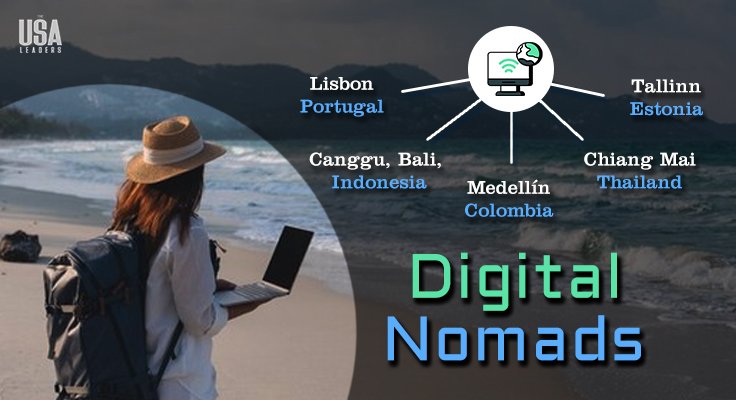Are you a digital nomad searching for your next adventure in 2025? Finding the perfect place for work and exploration is key. Some destinations offer affordable living, fast internet, and thriving communities, while others bring cultural richness and breathtaking views. Digital Nomads often look for balance—work-friendly spaces, a vibrant lifestyle, and opportunities to connect with others.But where should you go next? This guide highlights the top five destinations, their benefits, and a few challenges to consider. From Lisbon’s cultural charm to Bali’s laid-back vibe, each place has something unique. Ready to plan your journey? Let’s dive into the best options for Digital Nomads in 2025!
Here are the top 5 destinations for Digital Nomads should take note of
1. Lisbon, Portugal
| Cost of Living | Internet Speed | Top Co-working Spaces | Key Features |
| €1,200–€1,500/month | 150 Mbps | Second Home, Heden | Vibrant culture and close to beaches |
Lisbon is a vibrant city that blends modern conveniences with historic charm. Its welcoming atmosphere and cultural richness make it a top choice for digital nomads.
Benefits:
One of Lisbon’s greatest appeals is its cultural richness. The city brims with history, from the cobbled streets of Alfama to iconic landmarks like the Belem Tower. This creates an inspiring backdrop for remote work. Lisbon also offers an exceptional quality of life. The mild Mediterranean climate and nearby beaches allow nomads to enjoy leisure activities year-round, balancing work with relaxation seamlessly.
Challenges:
However, Lisbon’s popularity comes with its downsides. Rising housing costs are a growing concern, driven by the influx of expats and digital workers. Affordable rentals can be difficult to find, especially in central areas. Additionally, locals often express frustration over the rising cost of living and displacement issues, which can create some social tension.
2. Canggu, Bali, Indonesia
| Cost of Living | Internet Speed | Top Co-working Spaces | Key Features |
| €1,200–€1,500/month | 150 Mbps | Second Home, Heden | Vibrant culture and close to beaches |
Canggu has a laid-back atmosphere that perfectly suits young professionals seeking a work-life balance. Its tropical setting and friendly community make it a haven for digital nomads.
Benefits:
Canggu thrives on its idyllic work-life balance. Digital nomads can start their mornings with yoga or a surf session before diving into their tasks. The availability of modern co-working spaces like Dojo Bali ensures that professionals can work in an inspiring and collaborative environment. Networking opportunities abound, thanks to the diverse mix of freelancers and entrepreneurs who flock to this destination.
Challenges:
Yet, Canggu is not without its drawbacks. Internet connectivity, while improving, can be inconsistent, particularly in remote areas. Additionally, adapting to local customs and overcoming language barriers can be challenging for new arrivals.
3. Medellín, Colombia
| Cost of Living | Internet Speed | Top Co-working Spaces | Key Features |
| €1,200–€1,500/month | 150 Mbps | Second Home, Heden | Vibrant culture and close to beaches |
Once known for its turbulent past, Medellín has reinvented itself as a modern hub for innovation and digital work in South America.
Benefits:
The “City of Eternal Spring” provides perfect weather conditions for year-round comfort. Medellín’s commitment to innovation is evident in places like Ruta N, a hub for tech enthusiasts and remote workers. Expats gravitate toward neighborhoods like El Poblado, where a strong sense of community helps newcomers feel at home.
Challenges:
Despite these advantages, safety concerns still linger. While the city has made significant strides, exercising caution remains necessary. Additionally, English is not widely spoken, so learning Spanish can greatly enhance the experience.
4. Chiang Mai, Thailand
| Cost of Living | Internet Speed | Top Co-working Spaces | Key Features |
| €1,200–€1,500/month | 150 Mbps | Second Home, Heden | Vibrant culture and close to beaches |
For years, Chiang Mai has been a favorite among digital nomads, thanks to its affordability and relaxed pace of life.
Benefits:
Chiang Mai’s low cost of living makes it a standout destination. Here, digital nomads can enjoy a comfortable lifestyle without stretching their budgets. The city’s cultural richness adds to its appeal. From traditional festivals to world-class street food, Chiang Mai offers countless experiences that go beyond work.
Challenges:
However, it has its limitations. Job opportunities within the city are limited for those looking to supplement their remote income with local employment. Additionally, while healthcare services in Chiang Mai are decent, some expats prefer to travel to Bangkok for specialized medical care.
5. Tallinn, Estonia
| Cost of Living | Internet Speed | Top Co-working Spaces | Key Features |
| €1,200–€1,500/month | 150 Mbps | Second Home, Heden | Vibrant culture and close to beaches |
Tallinn stands out for its advanced digital infrastructure and forward-thinking policies. It’s a prime choice for tech-savvy digital nomads.
Benefits:
Estonia has led the way with its e-Residency program, which allows entrepreneurs to establish businesses in the EU with ease. Tallinn itself offers a unique cultural experience, blending medieval architecture with modern amenities. This mix creates a dynamic environment for both work and exploration.
Challenges:
Despite its perks, Tallinn’s cold winters can be a significant drawback, especially for those used to milder climates. While many locals speak English, learning some Estonian can greatly improve day-to-day interactions and integration into the community.
Conclusion
In 2025, Digital Nomads have incredible options to explore. From Lisbon’s vibrant culture to Bali’s tropical charm, each destination offers unique benefits. Medellín, Chiang Mai, and Tallinn stand out for affordability, community, and modern infrastructure. However, challenges like rising costs or cultural differences exist. Choosing the right place depends on your lifestyle and work needs. Stay curious, explore wisely, and embrace the adventure of being a digital nomad!
FAQs
- What is a digital nomad?
A digital nomad is someone who works remotely while traveling to different places. They use technology to earn a living and stay connected.
- How do digital nomads make a living?
Digital nomads make money through online jobs. Popular roles include freelance writing, teaching, graphic design, and digital marketing.
- What is the best country to live as a digital nomad?
Spain is one of the best countries for digital nomads. Its sunny climate, fast internet, and rich culture make it ideal.
- What are common digital nomad jobs?
Here are some common jobs for digital nomads:
- Writing and Editing
- SEO and digital marketing
- Social media content creation
- Graphic design and job at UI/UX design companies
- Online tutoring and language teaching
- Virtual business administration
- Do digital nomads travel alone?
Yes, many digital nomads travel alone. However, solo travel doesn’t have to be lonely. It offers freedom and new opportunities.
- How do I become a digital nomad?
To become a digital nomad, follow these steps:
- Start networking: Build connections online or in person.
- Pursue courses: Take online certifications to improve your skills before starting your journey.
- Who was the first digital nomad?
Steven K. Roberts was the first digital nomad. He worked remotely while traveling on a high-tech bike in the 1980s.





















